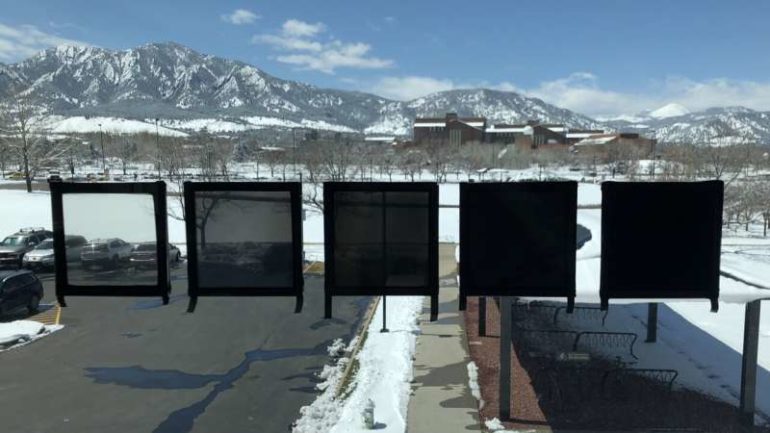Dynamic windows are a valuable technology that can help to decrease the carbon footprint of buildings. Dynamic windows are a class of windows with adjustable tint that allow users greater control over the flow of light and heat passing through them.
Researchers at Stanford University and University of Colorado- Boulder (UC Boulder) recently created new dynamic windows that are >900cm2 in size. These windows, presented in a paper published in Nature Energy, were fabricated using polymer inhibitors to reversibly deposit metal films with a controlled morphology in dynamic windows.
“The motivation for our work on dynamic windows was to create a product that saves energy and improves people’s lives at the same time,” Michael Strand, co-founder of Tynt Technologies and the lead researcher behind the study, told TechXplore. “Our main idea was to demonstrate that the core technology we have developed, reversible metal electrodeposition (RME), is ready to meet that goal.”
In their paper, Strand and his colleagues focused on scaling up the size of dynamic windows they had created as part of their previous research. This ultimately allowed them to create the largest dynamic windows of their kind demonstrated to date.
In addition, the researchers outlined the key advantages of RME technology over incumbent dynamic window solutions created in the past. These advantages include a neutral color, exceptional contrast and the potential for lower cost.
Engineers have been experimenting with the use of polymer inhibitors to enhance traditional electroplating processes for some time now. While past studies showed that polymer inhibitors can promote the growth of smooth and dense metal films, so far no one ever demonstrated their use in RME systems.
“We believed that if we could identify the right polymer for our dynamic windows, it would solve many of the remaining challenges related to scale, performance and durability,” Strand told TechXplore. “We feel the implications of this work extend far beyond the numerous benefits to our dynamic windows.”
To identify the most promising material for their dynamic windows, Strand and his colleagues screened and evaluated several different polymers. They added each of these polymers to the electrolyte layer of their dynamic windows and then measured their performance, focusing on key metrics like tinting speed, optical properties and electrical efficiency. In this initial screening process, the researchers found that polyvinyl alcohol (PVA) was the most promising material for their windows.
“While we started the project with some intuition that polymer inhibitors would improve our dynamic windows, the results really blew away our expectations,” Strand said. “The simple addition of PVA to our electrolyte (which adds no complexity or cost) improved nearly every performance parameter of our dynamic windows (by orders of magnitude in some cases).”
The dynamic windows created by Strand and his colleagues were found to outperform previously proposed solutions in several ways. In addition to being larger (>900 cm2), their windows had longer expected lifetimes (i.e., thousands of tinting cycles and an excellent shelf life) and achieved an improved solar modulation for energy savings (i.e., a larger optical range than any existing technology to date).
“Our work shows that reversible metal electrodeposition can enable dynamic windows with the combination of color, darkness and cost that people have long wanted,” Mike McGehee, another researcher who carried out the study, told TechXplore. “I’ve never seen anyone make a 900 square centimeter sized electronic device in a university lab before. The fact that Michael Strand and Tyler Hernandez were able to do that bodes well for commercialization.”
While dynamic windows have many benefits, so far, they have rarely been deployed in buildings, primarily due to limitations associated with their cost, speed and efficiency. The new dynamic windows created by Strand, McGehee and their colleagues could ultimately help to overcome these limitations, allowing architects to decrease the carbon footprint of buildings, while also improving the comfort of their occupants.
The recent study by this team of researchers shows that adding polymers or small molecules to the electrolyte layer of dynamic windows can impact almost every aspect of the devices. Their findings could thus aid the development of larger dynamic windows and other similar technologies with tunable colors and optical characteristics.
“Our dynamic windows are also very similar to advanced metal-anode batteries (QuantumScape technology), which are getting lots of attention,” Strand said. “Our advancement in understanding the role of polymers for controlling metal electroplating may also help battery researchers make the breakthroughs required to deliver the large-scale storage we need to support the sustainable energy revolution.”
Strand, McGehee and their colleagues now plan to continue investigating RME technology and assessing its relevance for a wide range of applications, ranging from the creation of greenhouses to the development of satellites. In addition, the researchers founded a company called Tynt, with the goal of commercializing the dynamic windows they created.
“Tynt’s primary mission is to bring the technology into people’s homes to create beautiful and comfortable indoor spaces with the added benefit of saving energy,” Strand said. “We believe these windows will create healthier homes and a healthier planet.”
Microsoft to unveil next generation of Windows on June 24
More information:
Polymer inhibitors enable >900 cm2 dynamic windows based on reversible metal electrodeposition with high solar modulation. Nature Energy(2021). DOI: 10.1038/s41560-021-00816-7
2021 Science X Network
Citation:
Using polymer inhibitors to enable larger dynamic windows (2021, June 11)
retrieved 11 June 2021
from https://techxplore.com/news/2021-06-polymer-inhibitors-enable-larger-dynamic.html
This document is subject to copyright. Apart from any fair dealing for the purpose of private study or research, no
part may be reproduced without the written permission. The content is provided for information purposes only.



